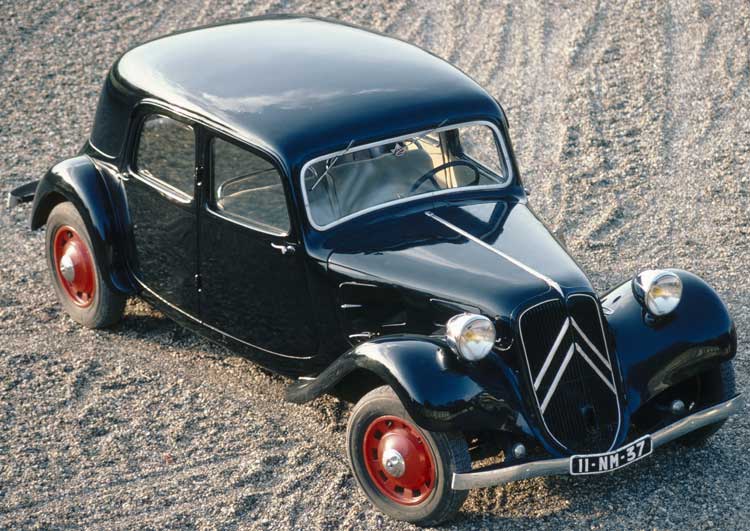Citroen Traction Avant
Brian Sewell hails the quirky, front wheel drive beauty that gave Citroën its reputation for audacity, innovation and eccentric quiddity

Until 1934, Citroën, a young giant of the motor industry whose first car was marketed in 1919, had offered to the French public vehicles that were conventional, reliable and cheap. Within a decade, an annual production of 100,000 had been reached, and the firm was the most prolific in Europe, fourth in world ranking, and André Citroën and his family were filthy rich. Not even the Great Depression, which decimated the industry worldwide, had much effect on Citroën - during the worst three years, one model, the C4, recorded an output just short of 250,000.
All this came to a sudden end in 1934, with Citroën himself a bankrupt and his factories absorbed into the Michelin empire - and of this disaster, the Traction Avant was the cause.
Old men still draw deep breaths at recollection of this car, which, at a stroke, gave the marque its reputation for audacity, innovation and eccentric quiddity, the world's first mass-produced monocoque with front wheel-drive. Other manufacturers had tried one or the other, but not both at the same time.
André Citroën was, then, in exultant mood; the factory was to be modernised to accommodate the American production methods required for this revolutionary car - a new concept, new body, new engine, new gearbox, new suspension, new, new, new. Sales of the existing range, however, faltered then plunged, but with ambition at one elbow and habitual extravagance at the other, André rushed headlong into financial crisis, laying off 8,000, losing his fortune, factory and firm.
A sad end for him, no doubt, but the car that caused it survived and, under Michelin, continued in production until 1957; that is, two years into the production run of the ID and DS - imagine, from 1955 to 1957, one could wander into a Citroën showroom in France and find the two great voitures révolutionnaires of the 20th century side by side, encapsulating more than 40 years of motoring history.
For 12 years, they had the same engine in common - an old-fashioned long-stroke iron lump in 1934, almost antique when it finally fell out of production in 1975. In its longest incarnation (1935-75), its capacity was 1,911cc, and this is the classic Traction Avant engine, giving at first 46bhp, and 10bhp more in its post-war prime, a top speed of 67mph with the first, 77mph in the last stage of development.
The classic body is known here as the Light Fifteen, a rakish four-door, four-light family saloon, with the spare wheel recessed into the boot-lid. Of this, before the war, there were two coupé versions, one closed, the other a two-seater drop-head (the hood completely disappearing) with a fold-flat windscreen and a dicky-seat; both are very rare.
On a longer wheelbase, there was an ungainly six-light saloon that could carry eight passengers, the Familiale, and of this a variation called the Commerciale had a huge opening tailgate in two parts so that it could be used as a mobile shop. On this same long wheelbase of 10ft 1 1/2 in, there was a 2.8l six-cylinder imitation of the Light Fifteen saloon, capable of seating six, again with coupé variants; only the saloon was revived after the war, fitted with the hydropneumatic suspension that then made the DS so spectacular.
A long wheelbase and flat floor made the Light Fifteen exceptionally roomy: "On the road ... the comfort of home'' was its advertising legend. It was also, as its English name indicates, exceptionally light, its weight, ready for the road with five passengers, the same as the equivalent Rover 14, empty and dry. This was due to its chassis-less monocoque construction, as its sheet steel was much the same. Outright performance figures now seem feeble - 25 seconds to reach a mile a minute, with 40mph the sensible maximum in the middle of its three gears - but its long-distance performance was much better than its immediate rivals, and a match for many a larger-engined car. Front-wheel drive and a low centre of gravity gave it tenacious road-holding, its long wheelbase and independent suspension smoothed bumps, and it rode very flat.
Only its heavy steering occasionally made it a bit tough to drive, though some nincompoops never got the hang of changing gear with a cranked lever through the dashboard, nor with double declutching into first.
But all of these things are mere details. What made the Traction Avant's reputation was the look of it - in 1934, so long and low and wide-seeming when most cars were tall, narrow and comparatively short; with a wheel in each corner, its wings short, sans overhang, running-boards, fussy detail, sold in just one colour, its elegance depended on simplicity; only its door handles hint at art deco, and of flashy American streamlining there's not a hint.
The body was the concept of Flaminio Bertoni, a young artist who turned to design. He it was who, in a single night (it is said), shaped a model of the Traction Avant in clay with sculptor's tools, as though he were Rodin forming a female nude.
In 1934, it looked like no other car; in 1946, it still seemed outrageously ahead of every Rover, Wolseley and Triumph; and in 1957, when finally put to rest, it was so eccentric as to be dateless. Next year, when the youngest will be half a century old, the Traction Avant will still be turning heads.
Subscribe to Independent Premium to bookmark this article
Want to bookmark your favourite articles and stories to read or reference later? Start your Independent Premium subscription today.

Join our commenting forum
Join thought-provoking conversations, follow other Independent readers and see their replies